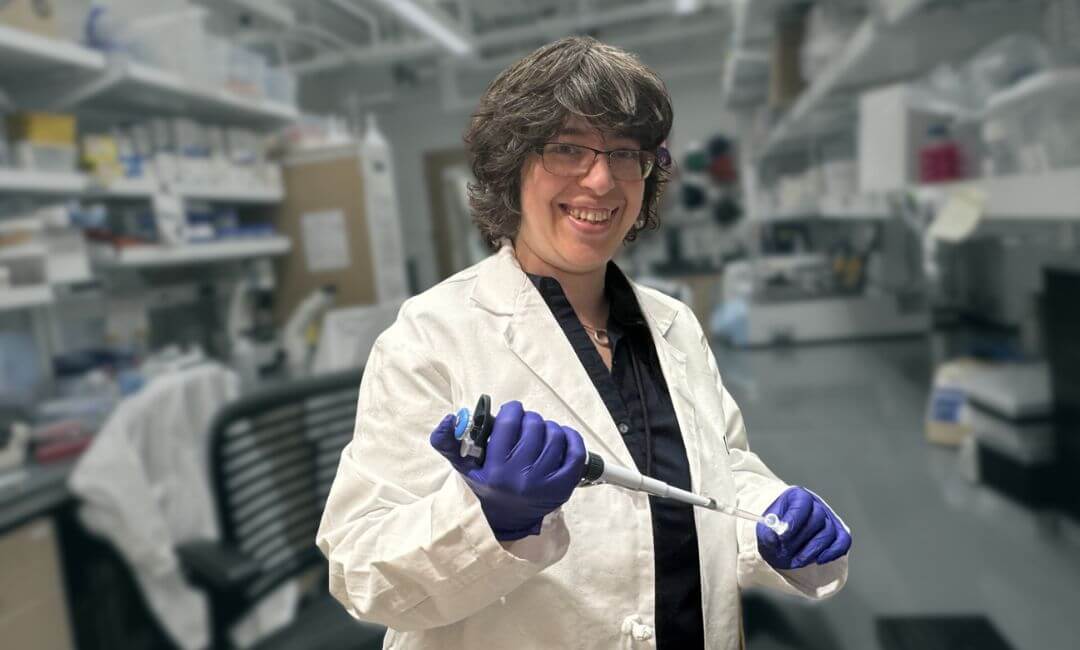When Rachael Gordon, MD, PhD, was an undergraduate, she was a bit uncertain about her precise career path, but she knew it would be in the sciences. After completing her degree, she found herself torn between clinical medicine and research, convinced she would not be happy simply doing one or the other. As she wasn’t quite ready to make the time commitment required for an MD/PhD degree, she took some time off after her bachelor’s degree to work as a research coordinator at the Hospital for Special Surgery in New York. It was there where she was first drawn to immunology and rheumatology while working in the lab of Lionel Ivashkiv, where she worked to build a rheumatoid arthritis registry. Outside of developing the registry, Gordon was provided freedom to explore other areas of research during her tenure in Ivashkiv’s lab, but her interactions with other rheumatological researchers and coursework crystallized her choice to pursue a career in immunology.
With a clearer vision of her career path, she applied to MD/PhD programs across the country, ultimately choosing the University of Pittsburgh. While she initially dabbled in cancer immunology and allergy immunology, she found herself continually returning to autoimmunity and eventually joined Dr. Mark Shlomchik’s lab, where she studied the role of neutrophil extracellular traps and NADPH oxidase in lupus pathogenesis. Convinced she would become a lupologist, she remained at Pitt for her internal medicine residency and fellowship.
“After medical school, I was trying to figure out where to go for the next phase, and after a long search, it became clear that no other place could justify to me that they were so superior to Pittsburgh that I could establish my career there in a way that would foster a lifestyle that I wanted to live.”
So, Gordon remained at Pitt with the intentions of continuing her lupus research. But, within the first year of her fellowship, Gordon found herself moving away from lupus research to another disease: Sjögren’s.
“Lupus, from a research perspective, is already getting a little crowded. And it was in my second year of fellowship, I realized that I had this patient population that I didn’t have any FDA-approved disease modifying therapies for, and they were miserable. These were my Sjögren’s patients. Sjögren’s is as common as rheumatoid arthritis, but we don’t have an FDA-approved, disease-modifying therapy to treat it! Rheumatoid arthritis, lupus, etc., have several treatment options, but that hasn’t been the case for Sjögren’s.”
Sjögren’s disease, a chronic autoimmune disease that affects tear- and saliva-producing glands with the potential to affect nearly any organ system in the body, affects roughly four million Americans, with a disproportionate amount being women. With so few clinical options for those that do suffer from the condition, Gordon wanted to be able to provide coordinated care for patients across Western Pennsylvania and the surrounding region. So, despite still being a fellow, she embarked on a mission to establish a new center focused on the disease at UPMC to help patients suffering with the disease. Moreover, Gordon knew that, with no faculty at Pitt currently engaged in Sjögren’s research, she had found her niche—one that would not only allow for numerous avenues for research, but also fill a void clinically.
And the rich environment at Pitt has been critical to her success, which has seen her efforts recently be rewarded with a Tobé and Stephen E. Malawista Endowment in Academic Rheumatology career development award and a 2024 Distinguished Fellow by the American College of Rheumatology. However, Gordon is quick to credit the inspiration and support she has received not only from Dr. Shlomchik, but others within the Division of Rheumatology and Clinical Immunology and at Pitt.
“You need really good mentors, mentors in different spaces, and it has to be a network of mentors, not just a single mentor…Throughout your training, you build a community. You build both a social community and a professional community, and you never know when that community will help you with something specific. So, it’s important to be collaborative and be helpful when you can.”
And the mentors and community Gordon has interacted with at the University of Pittsburgh School of Medicine and UPMC have been critical to her career development and success. Those mentors include Drs. Robyn Domsic, whose work with scleroderma registries inspired Gordon’s own efforts with building a similar one for Sjögren’s; Andreea Coca, who volunteered during her days off to supervise Gordon while she performed ophthalmologic evaluations; Jeremy Tilstra, who similarly trained with Shlomchik; and her division chief, Dana Ascherman, who has been tremendously supportive of Gordon’s efforts to build the new clinic.
“If you had asked me 15 years ago, ‘Would you ever leave New York?’, the answer would be ‘Hell no.’ But the program here (Pittsburgh) is on an upward curve. We have a cohort that’s better together and rising together. We have the critical mass. I would love to build my career here, and my plan is to stay.”

